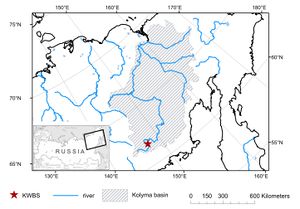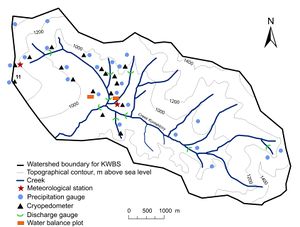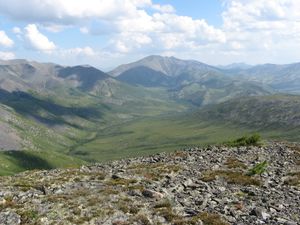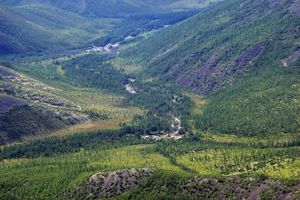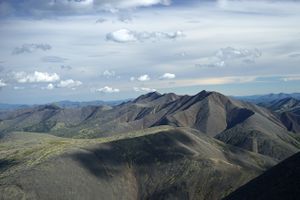Kolyma Water-Balance Station
Location
The Kolyma Water-Balance Station (KWBS) is situated in the zone of continuous permafrost in the upper reaches of the Kolyma River, North-Eastern Siberia. It includes Kontaktovy Creek catchments and its tributaries
Catchment size
KWBS is made up of nine small catchments with areas ranging from 0.27 to 21.2 km2.
Climate
Climate is continental and moderately humid. Mean annual temperature for the period 1950–1990 is estimated as −11.6°С, total annual precipitation varies from 250 to 440 mm.
Geology
Alluvial deposits occur in the Kontaktovy Creek valley, and residual and talus accumulations occur on hillslopes.
Topography
KWBS is located within the Kolyma Plateau. Elevation varies from 830 m to 1700 m asl, with maximum slope angles of 40° and an average slope angle of 22°.
Vegetation/Land use
Soil-vegetation cover varies considerably, apparently dependent on slope characteristics. Rocky talus (or golets) and tundra on the upper parts of hillslopes and ridges comprise 35 per cent of the area of the KWBS, and south-facing slopes occupied by dwarf cedar tree groves account for 26 per cent. Sparse larch tree growth on north-facing slopes and larch forests with a dense moss-lichen carpet in creek valley bottoms cover about 12 per cent and 27 per cent of the area, respectively.
Context of investigation
The station was built on the 15th of October 1947. First observations of the water runoff were started in May 1948, at the Kontaktovy and the Vstrecha Creeks. Several rainfall gauges operated at the Vstrecha Creek catchment during 8 years (between 1949 and 1957). Multiple special observations were initiated at the same time on runoff and water-balance sites, including observations of the evaporation from the soil, water and snow surface as well as observations of ground freezing and thawing in different conditions. The observations program expanded from year to year, and the most remote and hard-to-access station zones were covered. In 1968 runoff measurements were started at the unique object, in the basin of the Morozov Creek. It doesn’t have any vegetative cover and completely composed of rocky talus. Before 1978 the water runoff was observed at nine catchments with the area from 0.27 km2 to 21.2 km2. The summer thawing depth was registered with >30 frost tubes (cryopedometers) located in different conditions. Purely experimental studies were also executed. For example, they included the study of the impact of intra-ground condensation on the water runoff with the use of original devices and installations (Boyarintsev et al. 1991). The station team included about 30 people with professional higher or secondary-level education.
Water balance observations were suspended at the KWBS since 1997. Only observations at the weather station as well as runoff observations at several creeks are presently carried out there without the participation of specialists-hydrologists.
Huge material of hydrometeorological observations was accumulated during 40 years of work at the KWBS. By 1989 they were published in 30 issues the first one of which covers the period between 1948 and 1957. Later issues were published every year (KWBS observation materials, 1948-1987).
The observation results were reflected in multiple publications (there are more than 100 of them) dedicated to different aspects of the runoff formation in the continuous permafrost zone, the active layer dynamics, the structure of the underlying surface and its impact on hydrological processes.
The collected materials are invaluable for building and test-ing of different models: runoff formation, climatic, environ-mental and vegetation dynamics (Kuchment et al. 2000; Lebedeva & Semenova 2012).
Measurements/Equipment
Standard hydrometeorological and special research and experimental measurements were carried out at the KWBS from 1948 to 1997 (Kolymskoye UGMS 1948–1991). Observations include heat and radiation balance, meteorological inputs, runoff, freeze-thaw measurements, soil temperature, groundwater depths in wells, evaporation from soil cover, snow surveys and water-balance studies. Since 1997, the observational program at KWBS has been limited to one meteorological station and several runoff gauges.
Links to project webpages
Kolyma water balance station at the Hydrograph model group website
References
Bantsekina T, Mikhailov V (2009) To the evaluation of the role of intra-ground condensation in thermal and water regimes of coarse-grained slope deposits. Earth Cryosphere XIII (1): 40-45 (in Russian)
Boyarintsev E (1986) Formation and calculation of maximum runoff in spring high water period in the rivers of Magadan district. Proceedings of scientific conference on problems of hydrology of rivers of zone Baikal/Amur railway and Far East. Leningrad Hydrometeoizdat: 136-145 (in Russian)
Boyarintsev E (1988). Azonal factors of rainfall runoff formation in the territory of Kolyma WBS. Proceedings DVNIGMI135: 67-93 (in Russian)
Boyarintsev E, Gopchenko E, Serbov N, Legostaev G (1991) To the issue of intra-ground condensation in active layer of permafrost. M. IC VNIIGMI-MCD No 1046 GM-91 (in Russian)
Boyarintsev E, Serbov N, Popova NI (2006) Formation of the spring high-water balance in minor catchments of the Upper Kolyma river mountainous areas (the Kolymskaya Water Gauge Station records). Bulletin of the SVNC DVO RAN 4: 12-19 (in Russian)
Boyarintsev, E.L., Gopchenko, E.D., Serbov, N.G. & Legostaev, G.P. 1991. To the problem of air vapor condensation in the permafrost active layer. Dep. ITs VNI-IGMIMTsD, No. 1046 GM-91 dated 16.01.91, 17 pp. (in Russian)
Glotov V (2002) Ground water of the Kontaktovy Creek watershed as a factor of general drainage system formation. In: Glotov V, Ukhov N (eds.) Factors affecting the formation of a general drainage system of minor mountain rivers in sub-arctic areas. SVKNII DVO RAN: Magadan (In Russian)
Glotov V, Glotova L. (2002) Geological-geomorphical and geocryopogical factors of surface flow formation of Kontaktovy Creek. In: Glotov V, Ukhov N (eds.) Factors affecting the formation of a general drainage system of minor mountain rivers in sub-arctic areas. SVKNII DVO RAN: Magadan (In Russian)
Gusev Ye, Nasonova O (2000) An experience of modelling heat and water exchange at the land surface on a large river basin scale. J. of Hydrology 233 (1-4): 1-18
Gusev Ye, Nasonova O, Dzhogan L (2006) The Simulation of Runoff from Small Catchments in the Permafrost Zone by the SWAP Model. Water Resources 33 (2): 133-145 (in Russian)
Korolev Yu (1982) Hydrological role of vegetation of Upper Kolyma. Izvestia Academy of Science USSR. Biological Series 4: 517-529 (in Russian)
Kuchment L, Gelfan A, Demidov I (2000) A Model of Runoff Formation on Watersheds in the Permafrost Zone: Case Study of the Upper Kolyma River. Water Resources 27 (4): 435-444 (In Russian)
Lebedeva L, Semenova O (2012) Coupled modelling of the active layer depth dynamics and runoff formation processes with an example of small watersheds of Kolyma water balance station. Proceedings of the Tenth International Conference on Permafrost Salekhard, Yamal-Nenets Autonomous District, Russia June 25–29 2: 231-236
Lebedeva L., Semenova O. (2013) Coupled modelling of soil thaw/freeze dynamics and runoff generation in permafrost landscapes, Upper Kolyma, Russia // In: Cold and Mountain Region Hydrological Systems Under Climate Change: Towards Improved Projections. IAHS Publ. 360, IAHS Press Ltd., Wallingford, UK: 118-124
Lebedeva L., Semenova O. (2013) Use of soil thaw/freeze depth data to verify hydrological modelling at poor gauged basins in permafrost regions // Die Bodenkultur 64 (3–4): 53-59
Lebedeva L., Semenova O., Vinogradova T. (2014) Simulation of Active Layer Dynamics, Upper Kolyma, Russia, using the Hydrograph Hydrological Model // Permafrost and Periglac. Process. 25 (4): 270–280 DOI: 10.1002/ppp.1821
Lebedeva, L. S., Semenova, O. M., Vinogradova, T. A. (2015) Calculations of seasonal thawing depth in different landscapes of the Kolyma water-balance station by means of hydrological model “Hydrograph” (part 2) // Earth Cryosphere 19 (2): 35–44 (in Russian)
Mikhailov VM, Bantsekina TV, Ushakov MV (2007) Investigations of the thermal characteristics of groundwater inflow into mountain rivers of the cryolithozone. Earth Cryosphere XI (4): 57-64 (in Russian)
Nasybulin, P.S. (1976) The representativity of runoff characteristics at the Kolyma water balance station for the upper Kolyma area. Natural resources of the USSR northeast. Vladivostok, AN DVIS IBPS, 32-41 (in Russian)
Observation’s materials of Kolyma Water-Balance station 1948-1990. 1959-1991. Magadan: Kolymskoe UGKS. Issues 1-34
Reynuk U (1959) Condensation in active layer of permafrost. Proceedings of All Union Scientific and Research Institute of Gold and Rare Metals 13: 1-24 (in Russian)
Semenova O, Lebedeva L, Beldiman I (2012) Calculation of runoff engineering characteristics under conditions of lack of hydrometeorological measurements in North-East of Russia. Proceedings of the Tenth International Conference on Permafrost 2: 371-376
Semenova O., Lebedeva L., Vinogradov Yu. (2013) Simulation of subsurface heat and water dynamics, and runoff generation in mountainous permafrost conditions, in the Upper Kolyma River basin, Russia // Hydrogeology Journal 21(1): 107-119 DOI:10.1007/s10040-012-0936-1Bantsekina T (2003) Peculiarities of hydrothermal regime of seasonal thawing layer in coarsely clastic rocks during spring-summer period (with an example of Upper Kolyma highland). PhD Thesis Yakutsk (in Russian)
Semenova O., Vinogradov Y., Vinogradova T., Lebedeva L. (2014) Simulation of Soil Profile Heat Dynamics and their Integration into Hydrologic Modelling in a Permafrost Zone // Permafrost and Periglac. Process. 25 (4): 257–269 DOI: 10.1002/ppp.1820
Slaugher, C.W. & Billelo, M.A. (1977) Kolyma Water Balance Station, Magadan oblast, Northeast U.S.S.R.: United Station - Soviet Scientific Exchange Visit, Special Re-port 77-155, Army Gold Regions Research and Engineering Laboratory. Hanover. 66 pp.
Suschanskiy S (1999) Peculiarities of elements, forming water balance in the watershed of Morozova Creek. Kolyma1: 33-40 (in Russian)
Suschanskiy S (2002) History of creation, methods, objects and some results of studiesin the Kolyma water balance station. . In: Glotov V, Ukhov N (eds.) Factors affecting the formation of a general drainage system of minor mountain rivers in sub-arctic areas. SVKNII DVO RAN: Magadan (In Russian)
Zhuravin S (2004) Features of water balance for small mountainous watersheds in East Siberia: Kolyma Water Balance Station case study. IAHS Publ. 290: 28-40
